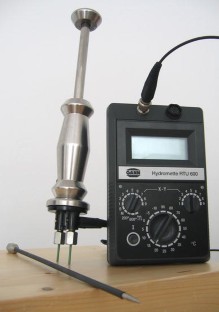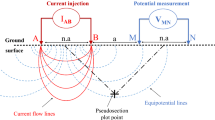Abstract
The reaction of wood to moisture forms an integral part of any task in connection with this natural and renewable building material. Changes in wood moisture content lead to changes of virtually all physical and mechanical properties (e.g. strength and stiffness properties) of wood. Another effect of changes of the wood moisture content is the associated shrinkage or swelling of the material. The existence of high moisture content can initiate decay or growth of fungi. The correct estimation of timber moisture content and the subsequent initiation of potentially necessary measures are therefore essential tasks during the planning, execution and maintenance of buildings built with wood or wood-based products. This is supported by the high amount of damages on structural timber elements that can be attributed to ignorance of the reaction of wood to moisture. Also supported by this fact, the in situ monitoring of moisture content of structural timber elements has recently received considerable interest and growth. This paper describes common methods to determine wood moisture content and evaluates them with respect to their applicability for monitoring concepts.






















Similar content being viewed by others
References
Kollmann F, Coté WA (1968) Principles of wood science and technology I: solid wood. Springer, Berlin
Niemz P (2003) Physik des Holzes und der Holzwerkstoffe. DRW-Verlag, Leinfelden-Echterdingen
Skaar C (1988) Wood–water relations. Springer, Berlin
Siau JF (1984) Transport processes in wood. Springer, New York
EN 1995-1-1:2004 (2004) Eurocode 5: design of timber structures—part 1-1: general—common rules and rules for buildings. European Committee for Standardization CEN, Brussels
Hawley LF (1931) Wood–liquid relations, Technical Bulletin Nr. 248, United States Department of Agriculture, Washington, DC
Keylwerth R (1949) Einfache Kontrollmessung bei der Holztrocknung. Holz-Zentralblatt 75:307–309
Stamm AJ, Harris EE (1953) Chemical processing of wood. Chem. Publ. Co., Inc., New York
EN 13183-1:2002 (2002) Moisture content of a piece of sawn timber—part 1: determination by oven dry method; European Committee for Standardization CEN, Brussels
Villari E (1886) Annalen der Physik und Chemie—Untersuchungen über einige Eigenschaften des mit seinen Fasern parallel oder transversal durchschnittenen Holzes, Bd. CXXXIII, Leipzig
Keylwerth R, Noack D (1956) Über den Einfluß höherer Temperaturen auf die elektrische Holzfeuchtigkeitsmessung nach dem Widerstandsprinzip. Holz als Roh- und Werkstoff 14(5):162–172
Ugolev B (1986) Holzkunde und Grundlagen der Holzwarenkunde, Lesnaja Prom, Moskau
Herrmann M (2009) Innovationen der Holzfeuchtemessung, Diploma Thesis, Chair for Timber Structures and Building Construction, Technische Universität München
EN 13183-2:2002 (2002) Moisture content of a piece of sawn timber—part 2: estimation by electrical resistance method; European Committee for Standardization CEN, Brussels
EN 13183-3:2005 (2005) Moisture content of a piece of sawn timber—part 3: estimation by capacitance method; European Committee for Standardization CEN, Brussels
Evans F, Kleppe O, Dyken T (2006) Monitoring of timber bridges in Norway—results, Report, Norsk Treteknisk Institut, Oslo
Gamper A, Dietsch P, Merk M, Winter S (2012) Building climate—long-term measurements to determine the effect on the moisture gradient in timber structures, Final Report. Lehrstuhl für Holzbau und Baukonstruktion, Technische Universität München
Gamper A, Dietsch P, Merk M, Winter S (2014) Building climate—validation of long-term measurements to determine the effect on the moisture gradient in timber structures, Final Report. Lehrstuhl für Holzbau und Baukonstruktion, Technische Universität München
Franke B, Müller A, Vogel M, Tannert T (2012) Langzeitmessung der Holzfeuchte und Dimensionsänderung an Brücken aus blockverleimten Brettschichtholz, Research report, Bern University of Applied Sciences, Switzerland
Dietsch P, Gamper A, Merk M, Winter S (2014) Monitoring building climate and timber moisture gradient in large-span timber structures. J Civil Struct Health Monit. doi:10.1007/s13349-014-0083-6
Franke S, Franke B, Müller A (2014) Case study—long term monitoring of timber bridges (this issue)
Franke B, Widmann R, Müller A, Tannert T (2013) Assessment and monitoring of the moisture content of timber bridges. In: Proceedings international conference on timber bridges, Las Vegas
Brischke C, Rapp AO (2007) Untersuchung des langfristigen Holzfeuchteverlaufs an ausgewählten Bauteilen der Fußgängerbrücke in Essing. Report Bundesforschungsanstalt für Forst- und Holzwirtschaft, Hamburg
Feldmeier F (2007) Ergebnisse und Schlussfolgerungen aus den Felduntersuchungen einer Eissporthalle. In: Proceedings Ingenieurholzbau—Karlsruher Tage, pp 98–104
Fellmoser P (2012) Langzeitüberwachung von Holztragwerken. In: Proceedings Ingenieurholzbau—Karlsruher Tage, pp 77–87
Schäfer W (2013) Konsequenter Holzschutz macht’s möglich—Grünbrücke Luckenwalde. Bauen mit Holz 9:16–21
Brischke C, Rapp AO, Bayerbach R (2008) Measurement system for long-term recording of wood moisture content with internal conductively glued electrodes. Build Environ 43(10):1566–1574
Author information
Authors and Affiliations
Corresponding author
Rights and permissions
About this article
Cite this article
Dietsch, P., Franke, S., Franke, B. et al. Methods to determine wood moisture content and their applicability in monitoring concepts. J Civil Struct Health Monit 5, 115–127 (2015). https://doi.org/10.1007/s13349-014-0082-7
Received:
Revised:
Accepted:
Published:
Issue Date:
DOI: https://doi.org/10.1007/s13349-014-0082-7




